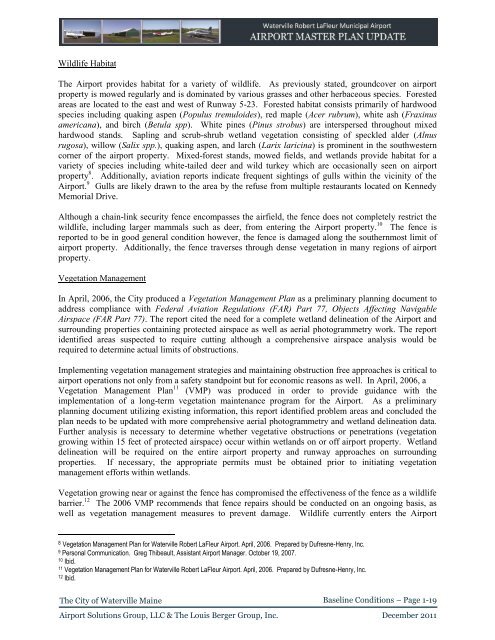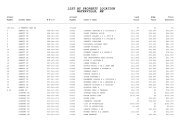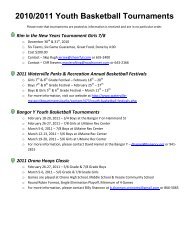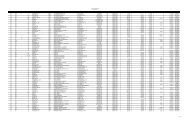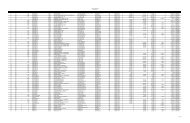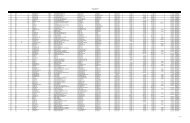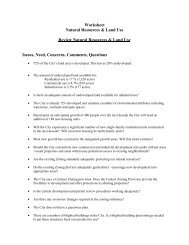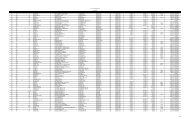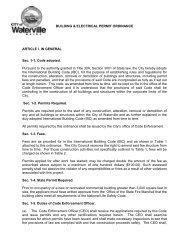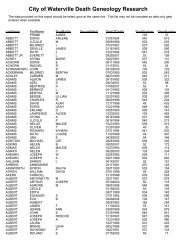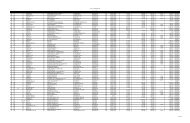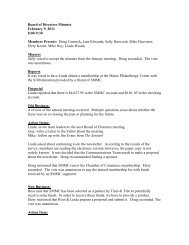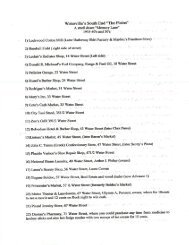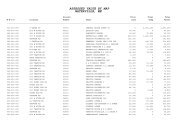Airport Master Plan 2012 - City of Waterville
Airport Master Plan 2012 - City of Waterville
Airport Master Plan 2012 - City of Waterville
Create successful ePaper yourself
Turn your PDF publications into a flip-book with our unique Google optimized e-Paper software.
Wildlife Habitat<br />
The <strong>Airport</strong> provides habitat for a variety <strong>of</strong> wildlife. As previously stated, groundcover on airport<br />
property is mowed regularly and is dominated by various grasses and other herbaceous species. Forested<br />
areas are located to the east and west <strong>of</strong> Runway 5-23. Forested habitat consists primarily <strong>of</strong> hardwood<br />
species including quaking aspen (Populus tremuloides), red maple (Acer rubrum), white ash (Fraxinus<br />
americana), and birch (Betula spp). White pines (Pinus strobus) are interspersed throughout mixed<br />
hardwood stands. Sapling and scrub-shrub wetland vegetation consisting <strong>of</strong> speckled alder (Alnus<br />
rugosa), willow (Salix spp.), quaking aspen, and larch (Larix laricina) is prominent in the southwestern<br />
corner <strong>of</strong> the airport property. Mixed-forest stands, mowed fields, and wetlands provide habitat for a<br />
variety <strong>of</strong> species including white-tailed deer and wild turkey which are occasionally seen on airport<br />
property 8 . Additionally, aviation reports indicate frequent sightings <strong>of</strong> gulls within the vicinity <strong>of</strong> the<br />
<strong>Airport</strong>. 9 Gulls are likely drawn to the area by the refuse from multiple restaurants located on Kennedy<br />
Memorial Drive.<br />
Although a chain-link security fence encompasses the airfield, the fence does not completely restrict the<br />
wildlife, including larger mammals such as deer, from entering the <strong>Airport</strong> property. 10 The fence is<br />
reported to be in good general condition however, the fence is damaged along the southernmost limit <strong>of</strong><br />
airport property. Additionally, the fence traverses through dense vegetation in many regions <strong>of</strong> airport<br />
property.<br />
Vegetation Management<br />
In April, 2006, the <strong>City</strong> produced a Vegetation Management <strong>Plan</strong> as a preliminary planning document to<br />
address compliance with Federal Aviation Regulations (FAR) Part 77, Objects Affecting Navigable<br />
Airspace (FAR Part 77). The report cited the need for a complete wetland delineation <strong>of</strong> the <strong>Airport</strong> and<br />
surrounding properties containing protected airspace as well as aerial photogrammetry work. The report<br />
identified areas suspected to require cutting although a comprehensive airspace analysis would be<br />
required to determine actual limits <strong>of</strong> obstructions.<br />
Implementing vegetation management strategies and maintaining obstruction free approaches is critical to<br />
airport operations not only from a safety standpoint but for economic reasons as well. In April, 2006, a<br />
Vegetation Management <strong>Plan</strong> 11 (VMP) was produced in order to provide guidance with the<br />
implementation <strong>of</strong> a long-term vegetation maintenance program for the <strong>Airport</strong>. As a preliminary<br />
planning document utilizing existing information, this report identified problem areas and concluded the<br />
plan needs to be updated with more comprehensive aerial photogrammetry and wetland delineation data.<br />
Further analysis is necessary to determine whether vegetative obstructions or penetrations (vegetation<br />
growing within 15 feet <strong>of</strong> protected airspace) occur within wetlands on or <strong>of</strong>f airport property. Wetland<br />
delineation will be required on the entire airport property and runway approaches on surrounding<br />
properties. If necessary, the appropriate permits must be obtained prior to initiating vegetation<br />
management efforts within wetlands.<br />
Vegetation growing near or against the fence has compromised the effectiveness <strong>of</strong> the fence as a wildlife<br />
barrier. 12 The 2006 VMP recommends that fence repairs should be conducted on an ongoing basis, as<br />
well as vegetation management measures to prevent damage. Wildlife currently enters the <strong>Airport</strong><br />
8 Vegetation Management <strong>Plan</strong> for <strong>Waterville</strong> Robert LaFleur <strong>Airport</strong>. April, 2006. Prepared by Dufresne-Henry, Inc.<br />
9<br />
Personal Communication. Greg Thibeault, Assistant <strong>Airport</strong> Manager. October 19, 2007.<br />
10<br />
Ibid.<br />
11<br />
Vegetation Management <strong>Plan</strong> for <strong>Waterville</strong> Robert LaFleur <strong>Airport</strong>. April, 2006. Prepared by Dufresne-Henry, Inc.<br />
12<br />
Ibid.<br />
The <strong>City</strong> <strong>of</strong> <strong>Waterville</strong> Maine<br />
Baseline Conditions – Page 1-19<br />
<strong>Airport</strong> Solutions Group, LLC & The Louis Berger Group, Inc. December 2011


